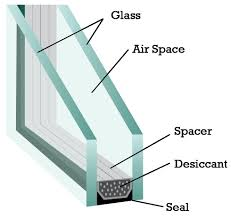What is Insulated Glazing?
 In this post, we offer a universal definition for insulated glazing. If you didn't know insulated glazing (IG) is the technical term for 'double glazing' and 'triple glazing'. In a nutshell, IG is essential two or more glass window panes separated by a vacuum or gas filled space.
In this post, we offer a universal definition for insulated glazing. If you didn't know insulated glazing (IG) is the technical term for 'double glazing' and 'triple glazing'. In a nutshell, IG is essential two or more glass window panes separated by a vacuum or gas filled space.
This vacuum is designed to reduce heat transfer from inside your building to the outside world. This ensures heat is not unnecessarily lost to the outside world through windows and doors. The glass that's used in this system is manufactured with a thickness that's between 3mm to 10mm. All panels of glass are typically of equal thickness.

A short history of insulated glazing
IG was first patented in 1865 by an American inventory called Thomas D. Stetson (1827-1916) during the American Civil War. Modern insulated glazing is an evolution of storm and sash windows (double-hung windows). A storm window was attached to a sash window during the winter. This additional layer of glass reduced heat loss from the inside and also prevent the draft entering the building from outside. However, storm windows were often criticised because it took an unreasonable amount of time to fix and remove them to windows.
And let's not forget storm windows are large, so they required space to store them during the spring and summer months.
For multi-story buildings, this bi-yearly swap-over was expensive and time-consuming. Thus, property owners welcomed the introduction of double glazing in mid-20th Century.
Benefits of insulated glazing
Below we list some of the benefits you gain when you choose to invest in IG:
- Reduces room condensation
- Greater energy efficiency
- Reduces sound transmission from outside - especially important for buildings near airports, railway stations and main roads
- Attractive aesthetics
- Improves comfort of building
- Increases light and view
- Greater thermal insulation
The uses of insulated glazing
When you think IG, you most probably think double glazing on windows and doors. And your instincts would be correct, at least partly. That's because the use of IG stretches much further than windows and doors. IG is also used in refrigerators, cars, buses, trains, and microwaves!

The technology behind insulated glazing
IG utilises technology known as a Fixed Insulated Glazing Unit (IGU). IGU sandwiches two panels of glass and separates them using a layer of air. IG thus eliminates the need for storm windows.
Because of this, IG results in a 77% typical heat gain compared to single pained windows. IG also means your home stays cool during the summer months. Unfortunately, metal and glass are good conductors of heat. This fact means traditional windows conduct heat from inside your home so that same heat escapes into the outside world.
However, the pockets of air or gas that separate each pane of glass in IG will retain heat from inside your home because air and gas are both poor conductors of heat. IGUs also have installed a spacer. This spacer separates each pane of glass. This spacer is typically made of structural foam. This is because foam is a poor conductor of heat. This prevents the loss of heat from rooms in your home to the world outside.
Before IG is installed in your home, a survey must be carried out. This is because IG units are generally not manufactured as standard units. This is because each home is different and over time the space your windows must fit into shifts due to the normal aging process.
An adhesive sealant is spread across the surface this space. This sealant is applied on each side in this space. Some units will be gas filled. This means the air between the panes is removed and replaced with gas. This gas is typically krypton or argon. Once complete, the units are sealed using a silicone sealant. This prevents outside air from penetrating into your home.

Comments
No Comments
Add a comment